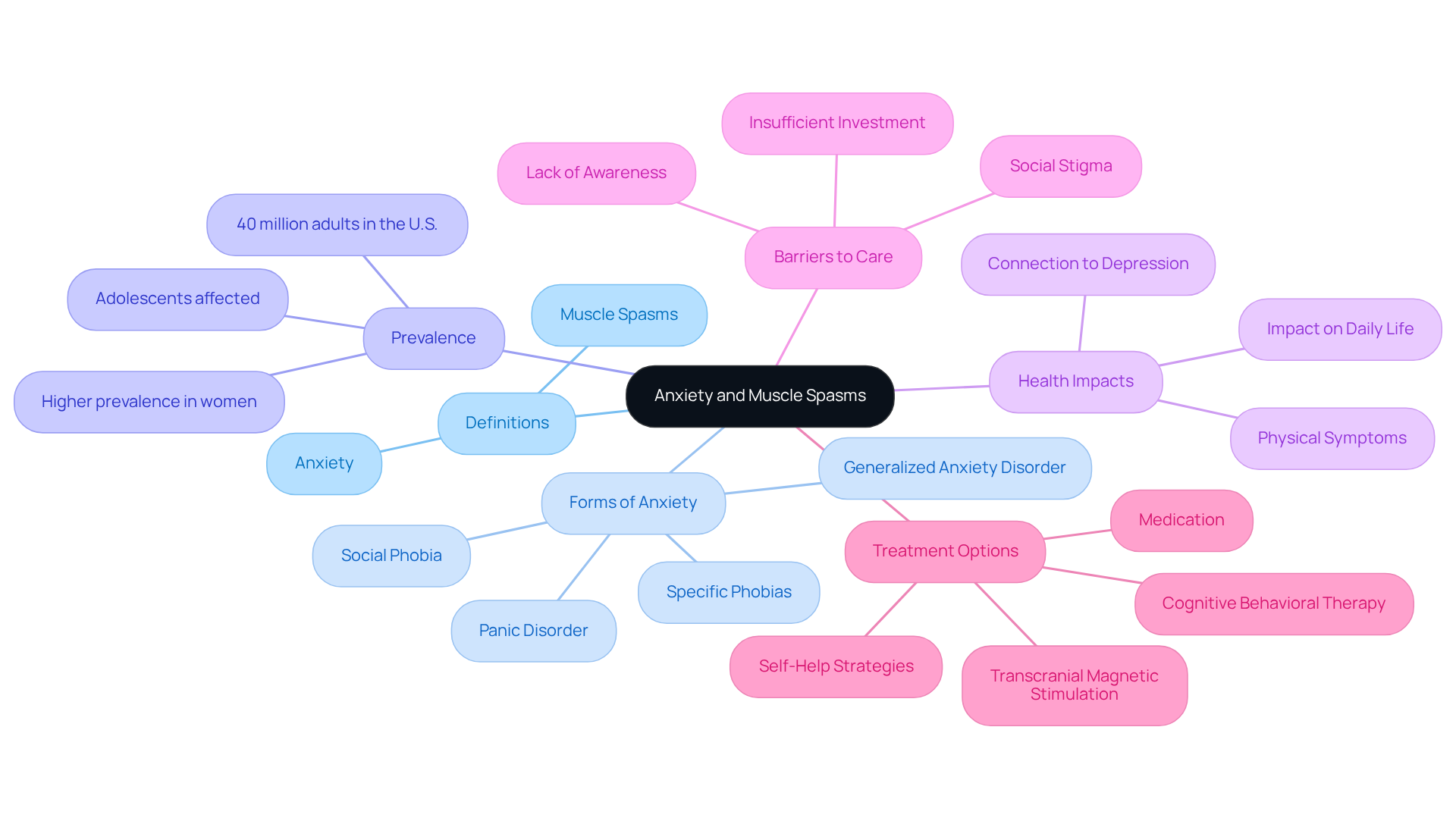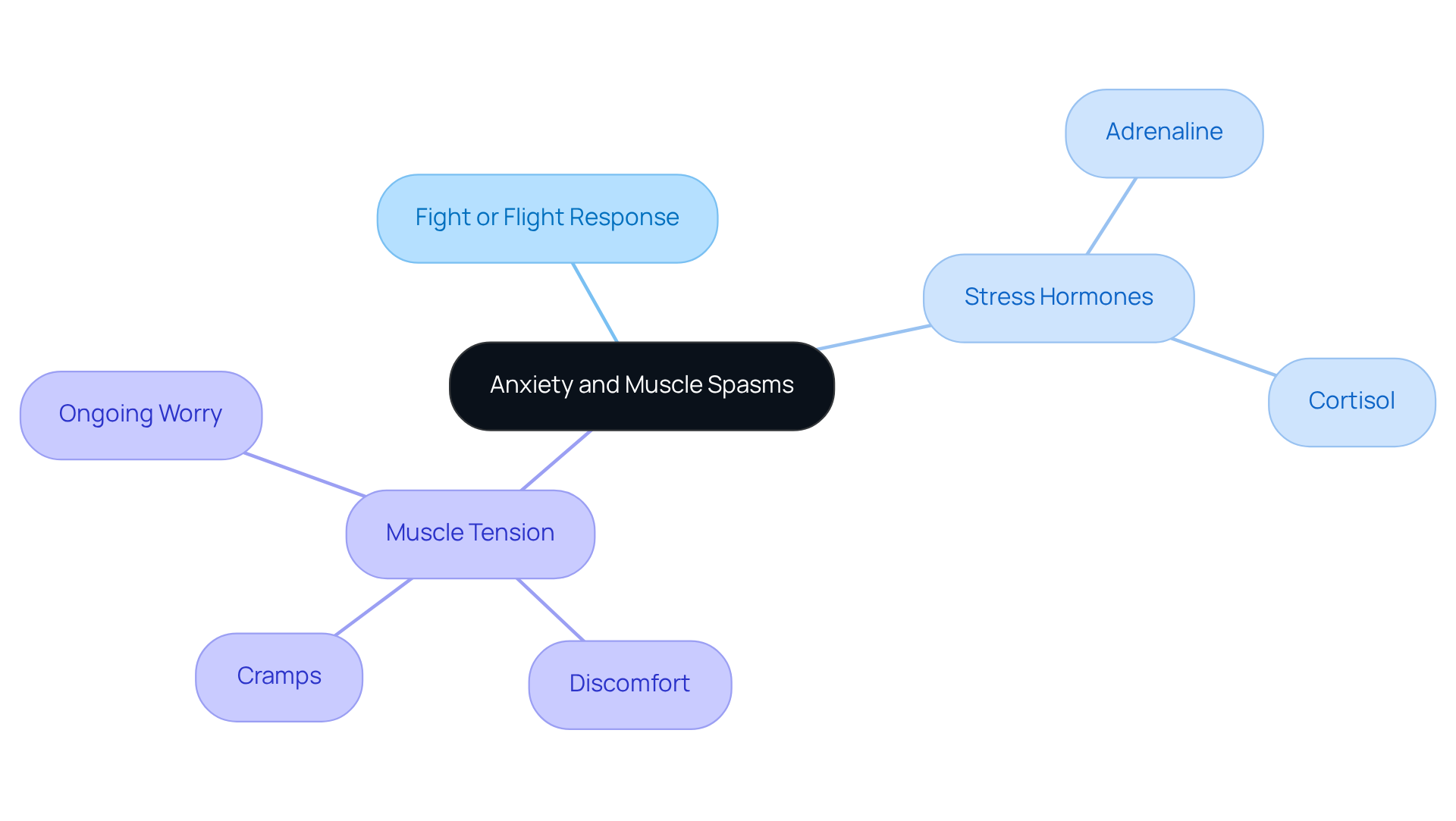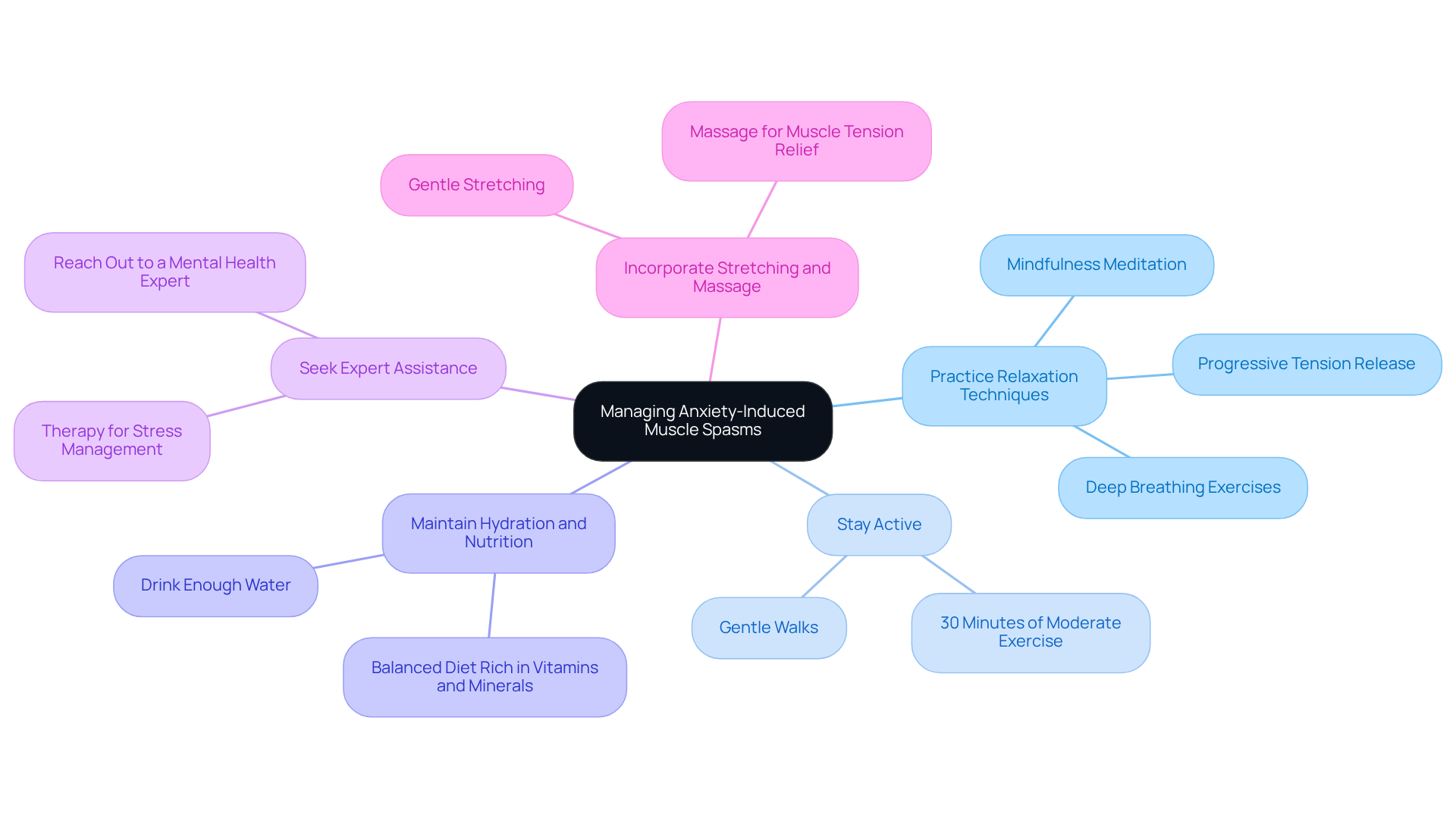Overview
Anxiety can indeed lead to muscle spasms, a response triggered by the body's natural stress reaction. Have you ever noticed how your muscles tighten when you're feeling anxious? This tightening can lead to discomfort, making it crucial to understand this connection. The release of stress hormones during anxious moments heightens muscle tension, which can be overwhelming.
Recognizing this relationship is a vital step toward finding effective management and relief strategies. As we explore this further, it becomes clear that acknowledging these physical symptoms is essential for healing. By understanding how anxiety manifests in our bodies, we can take proactive steps towards nurturing our well-being.
Seeking support and therapy can be a powerful way to address these feelings and find peace. Remember, you are not alone in this journey, and there are paths to relief and healing.
Introduction
Anxiety is a widespread mental health condition that impacts millions of lives, often showing up in unexpected and uncomfortable ways. One such expression is muscle spasms, which can leave individuals struggling with both physical discomfort and emotional turmoil. As we delve into the intricate relationship between anxiety and muscle spasms, we aim to shed light on how anxiety can trigger these involuntary contractions.
Moreover, we will explore effective strategies for relief that can help you regain control. Can understanding this connection lead to better management of both your mental and physical health?
Define Anxiety and Muscle Spasms: Understanding the Basics
Anxiety is more than just a feeling; it’s a mental health condition that many people experience, characterized by excessive worry, fear, or apprehension about future events. It can manifest in various forms, such as generalized anxiety disorder, panic disorder, and social phobia. Involuntary contractions, on the other hand, are unexpected tightenings of one or more tissues, often leading to discomfort or pain. Understanding these definitions is crucial, as they help explain how can anxiety cause muscle spasms due to the body's stress response. Recognizing this connection is a vital first step in addressing the issue effectively.
Did you know that anxiety affects approximately 40 million adults in the United States? This highlights the widespread nature of this condition and the importance of understanding it. Mental health experts emphasize that worry can significantly impact bodily well-being and everyday life, with signs often beginning in childhood or teenage years. However, obstacles to care, such as lack of awareness and social stigma, can complicate the management of worry and its physical manifestations.
Incorporating effective treatment methods, such as cognitive behavioral therapy, can be a beacon of hope for individuals struggling with anxiety. Have you ever felt overwhelmed by your worries? Seeking help is a courageous step towards healing. By addressing both the emotional and physical aspects of anxiety, individuals can learn to manage their stress and its associated symptoms, while also understanding how can anxiety cause muscle spasms, paving the way for a healthier, more fulfilling life.

Explore the Physiological Link: How Anxiety Triggers Muscle Spasms
When you encounter stress, your body may enter a state of heightened alertness, often known as the 'fight or flight' response. This natural reaction triggers the release of stress hormones, such as adrenaline and cortisol, preparing you to respond to perceived threats. As a result, you might notice that your muscles tighten, which can lead to discomfort or cramps, raising the question of whether can anxiety cause muscle spasms.
Have you ever felt this way? It's important to recognize that ongoing worry can extend this tension in your body, which makes one wonder, can anxiety cause muscle spasms? Understanding this connection between stress and physical sensations is crucial. It helps us see why feelings of nervousness can manifest in our bodies and raises the question of whether can anxiety cause muscle spasms, including those unwelcome contractions.
As we explore this further, remember that acknowledging these feelings is the first step towards healing and finding relief.

Implement Strategies for Relief: Managing Anxiety-Induced Muscle Spasms
Managing anxiety-induced muscle spasms can feel overwhelming, but understanding how anxiety can cause muscle spasms can help you find gentle strategies for relief. Have you ever felt the weight of anxiety manifesting in your body? Let’s explore some compassionate approaches together.
-
Practice Relaxation Techniques: Engaging in deep breathing exercises, progressive tension release, or mindfulness meditation can significantly reduce your anxiety levels and bodily tension. These practices invite calmness and help you reconnect with your body.
-
Stay Active: Regular physical activity is not just beneficial for your body; it can also uplift your mood. Aim for at least 30 minutes of moderate exercise most days of the week. Remember, even a gentle walk can make a difference.
-
Maintain Hydration and Nutrition: It’s essential to stay hydrated and nourished. Dehydration and nutrient deficiencies can worsen cramps, so ensure you drink enough water and consume a balanced diet rich in vitamins and minerals. Your body deserves this care.
-
Seek Expert Assistance: If feelings of nervousness and bodily contractions persist, it might be time to reach out to a mental health expert. Therapy can provide you with valuable resources to manage stress effectively and address its physical symptoms. You don’t have to navigate this alone.
-
Incorporate Stretching and Massage: Gentle stretching and massage can be wonderfully soothing, helping to relieve muscle tension and reduce the frequency of spasms. Consider weaving these practices into your daily routine as acts of self-care.
By implementing these nurturing strategies, you can better manage the physical manifestations of anxiety and explore how anxiety can cause muscle spasms, paving the way for improved overall well-being. Remember, taking small steps towards healing is a journey worth embarking on.

Conclusion
Understanding the intricate relationship between anxiety and muscle spasms reveals how emotional distress can manifest physically. Have you ever felt overwhelmed by worry and fear? Anxiety can lead to involuntary muscle contractions, causing discomfort and pain. Recognizing this connection is essential for those seeking to alleviate both their mental and physical symptoms.
The article highlights several key points, including:
- The physiological response of the body to stress, which triggers muscle tension and spasms.
- The importance of acknowledging these feelings and implementing strategies for relief.
Consider practices like:
- Relaxation techniques
- Regular exercise
- Proper nutrition
- Seeking professional help
Each of these approaches plays a vital role in managing anxiety-induced muscle spasms and improving overall well-being.
In conclusion, addressing anxiety and its physical manifestations is crucial for a healthier life. By taking proactive steps towards understanding and managing anxiety, individuals can significantly reduce the impact of muscle spasms and enhance their quality of life. Embracing these strategies not only fosters personal healing but also promotes a deeper awareness of the mind-body connection. This encourages a more holistic approach to mental health, inviting you to explore the journey towards wellness.
Frequently Asked Questions
What is anxiety?
Anxiety is a mental health condition characterized by excessive worry, fear, or apprehension about future events. It can manifest in various forms, including generalized anxiety disorder, panic disorder, and social phobia.
What are muscle spasms?
Muscle spasms are involuntary contractions of one or more tissues, often resulting in discomfort or pain.
How can anxiety cause muscle spasms?
Anxiety can lead to muscle spasms due to the body's stress response, which may result in unexpected tightenings of muscles.
How prevalent is anxiety in the United States?
Anxiety affects approximately 40 million adults in the United States, highlighting its widespread nature.
What impact does anxiety have on overall well-being?
Anxiety can significantly impact bodily well-being and everyday life, with its signs often beginning in childhood or teenage years.
What are some obstacles to managing anxiety?
Obstacles to managing anxiety include a lack of awareness and social stigma surrounding mental health conditions.
What treatment methods are effective for anxiety?
Effective treatment methods for anxiety include cognitive behavioral therapy, which addresses both the emotional and physical aspects of the condition.
Why is seeking help for anxiety important?
Seeking help is important because it is a courageous step towards healing, allowing individuals to manage their stress and associated symptoms for a healthier life.




